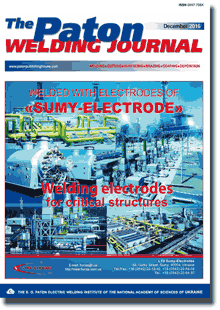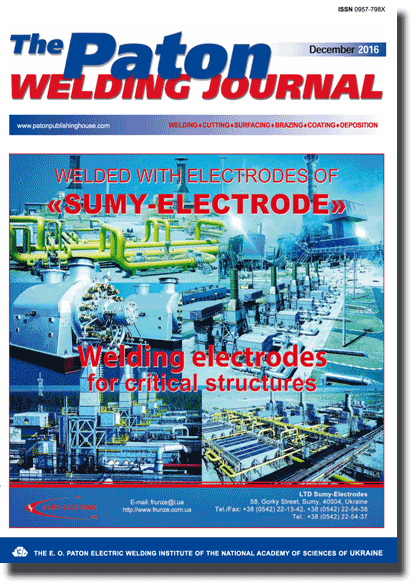| 2016 №12 (02) |
DOI of Article 10.15407/tpwj2016.12.03 |
2016 №12 (04) |

The Paton Welding Journal, 2016, #12, 13-20 pages
Direct numerical Modelling of formation of weld metal dendrite structure with disperse refractory inoculants
D.Yu. Ermolenko, A.V. Ignatenko And V.V. Golovko
E.O. Paton Electric Welding Institute, NASU 11 Kazimir Malevich Str., 03680, Kiev, Ukraine. E-mail: office@paton.kiev.ua
Abstract
Studied were the advantages of alloy feeding with the disperse refractory inoculants for regulation and optimizing the primary structure of high-strength low-alloy steel weld metal. The main assumptions and limitations of a model of weld metal solidification process, proposed in this work, were considered. The model of melt solidification was described in details taking into account effect of the introduced disperse refractory inoculants. A hypothesis was presented on mechanism of interaction of a refractory inoculant with moving solidification front, which was taken in computations. Effect of the different alloying elements on surface energy of phase interface was described. Boundary conditions of the proposed model, realized in form of author software, were described. The results are given of computational experiments showing the possibilities of regulation of parameters and morphology of the primary structure of high-strength low-alloy steel weld metal by means of melt feeding with the disperse refractory inoculants (by example of TiO2 introduction). Presented is a comparison of experimental and computational results of change of the primary structure parameters. Developed mathematical model and software, written on its basis, are good for prediction of dimensional parameters and morphology of the weld metal primary structure considering refractory inoculants being fed in the weld pool. 17 Ref., 1 Table, 10 Figures.
Keywords: dendrite structure, disperse refractory inoculants, solidification, high-strength low-alloy steels, morphology, mathematical modelling
Received: 26.10.16
Published: 24.01.17
References
- Sandeep, J., Chhibber, R., Mehta, N.P. (2012) Issues in welding of hsla Advanced Materials Research, 365, 44–49.
- Golovko, V.V., Pokhodnya, I.K. (2013) Effect of non-metallic inclusions on formation of structure of the weld metal in high-strength low-alloy steels. The Paton Welding J., 6, 2–10.
- Ermolenko, D.Yu., Golovko, V.V. (2014) Numerical modeling and prediction of weld microstructure in high-strength steel welding (Review). Ibid., 3, 2–10. https://doi.org/10.15407/tpwj2014.03.01
- Golovko, V.V., Stepanyuk, S.N., Ermolenko, D.Yu. (2015) Effect of titanium-containing inoculants on structure and properties of weld metal of high-strength low-alloy steels. Ibid., 2, 14–18. https://doi.org/10.15407/tpwj2015.02.03
- Galenko, P.K., Krivilev, M.D. (2000) Isothermal growth of crystals in undercooled binary alloys. Matematicheskoe Modelirovanie, 12(11), 17–37.
- Galenko, P., Danilov, D. (1997) Local nonequilibrium effect on rapid dendritic growth in binary alloy melt. Physics Letters A, 235(3), 271–280. https://doi.org/10.1016/S0375-9601(97)00562-8
- Mullins, W.W., Sekerka, R.F. (1964) Stability of the planar interface during crystallization of a dilute binary alloy. Applied Physics, 35, 444–459. https://doi.org/10.1063/1.1713333
- Kurz, W., Fisher, D.J. (1992) Fundamentals of solidification. Tech. Publications Ltd.
- Galenko,P., Sobolev, S. (1997) Local nonequilibrium effect on undercooling in rapid solidification of alloys. Physical Review E, 55(1), 343–352. https://doi.org/10.1103/PhysRevE.55.343
- Pavlyk, V. (2004) Modeling and direct numerical simulation of dendritic structures under solidification conditions during fusion welding. Aachen: Shaker Verlag GmbH.
- Galenko, P.K., Krivilev, M.D. (2000) Finite-difference scheme for modeling of crystalline structure formation in undercooled binary alloys. Matematicheskoe Modelirovanie, 12(12), 11–13.
- Guillemot, G., Gandin, C.-A., Combeau, H. (2006) Modeling of macrosegregation and solidification grain structures with a coupled cellular automaton-finite element model. ISIJ , 46(6), 880–895. https://doi.org/10.2355/isijinternational.46.880
- Sasikumar, R., Sreenivasan, R. (1994) 2-dimensional simulation of dendrite morphology. Acta Metallurgica et Materialia, 7(2), 2381–2386. https://doi.org/10.1016/0956-7151(94)90316-6
- Panasyuk, A.D., Fomenko, V.S., Glebova, G.G. (1986) Resistance of non-metallic materials in melts. Kiev: Naukova Dumka.
- Popel, S.I. (1971) Theory of metallurgical processes. Moscow: VINITI.
- Diltey, U., Pavlik, V., Raihel, T. (1997) Computer modeling of formation of weld metal microstructure in fusion welding. Svarka, 3, 3–9.
- Golovko, V.V., Stepanyuk, S.N., Ermolenko, D.Yu. (2014) Technology of welding of high-strength low-alloy steels by introduction of titanium-containing inoculants. In: Nanodimensional Systems and Nanomaterials: Research in Ukraine. Monography. Ed. by A.G. Naumovets. Kiev: Akademperiodika.
Suggested Citation
D.Yu. Ermolenko, A.V. Ignatenko And V.V. Golovko (2016) Direct numerical Modelling of formation of weld metal dendrite structure with disperse refractory inoculants. The Paton Welding J., 12, 13-20.The cost of subscription/purchase order journals or individual articles
| Journal/Currency | Annual Set | 1 issue printed |
1 issue |
one article |
| TPWJ/USD | 384 $ | 32 $ | 26 $ | 13 $ |
| TPWJ/EUR | 348 € | 29 € | 24 € | 12 € |
| TPWJ/UAH | 7200 UAH | 600 UAH | 600 UAH | 280 UAH |
| AS/UAH | 1800 UAH | 300 UAH | 300 UAH | 150 UAH |
| AS/USD | 192 $ | 32 $ | 26 $ | 13 $ |
| AS/EUR | 180 € | 30 € | 25 € | 12 € |
| SEM/UAH | 1200 UAH | 300 UAH | 300 UAH | 150 UAH |
| SEM/USD | 128 $ | 32 $ | 26 $ | 13 $ |
| SEM/EUR | 120 € | 30 € | 25 € | 12 € |
| TDNK/UAH | 1200 UAH | 300 UAH | 300 UAH | 150 UAH |
| TDNK/USD | 128 $ | 32 $ | 26 $ | 13 $ |
| TDNK/EUR | 120 € | 30 € | 25 € | 15 € |
AS = «Automatic Welding» - 6 issues per year;
TPWJ = «PATON WELDING JOURNAL» - 12 issues per year;
SEM = «Electrometallurgy Today» - 4 issues per year;
TDNK = «Technical Diagnostics and Non-Destructive Testing» - 4 issues per year.


